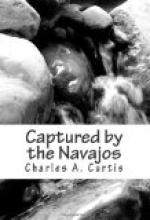The evening was well advanced when we pitched our tents at the dry camp. Horses and mules were turned out to graze for the first time without water, and although in this mountain region the grass was abundant, they did not cease to whinny and bray their discontent throughout the night.
The sun dropped behind the mountain spurs, and we drew nearer and nearer the fires, adding a thicker garment as the twilight deepened into night. Frank expressed the trend of thought by asking, “We now march into the heart of the Navajo country, do we not, sir?”
“Not precisely through the heart, but along its southern border.”
“They’ll try to make it lively for us, I suppose?”
“They will certainly watch us closely, and will take advantage of any carelessness on our part.”
“Do you think there is any chance of our finding Manuel Perea?”
“Hardly; he is too far off our route. We cannot leave the train to look him up.”
There was a suspicious choke in the voice of the little corporal when he said: “It is awful to think we are going so near the dear old boy and can do nothing for him. Only think of his poor mother!”
“I was told at the fort that she has offered five thousand dollars to the man who will bring Manuel to her,” said Frank. “I wish I could bring him in for nothing.”
“Brenda says she believes we shall find him somehow,” Henry said. “I hope she is right, for I saw his mother at Algodones and promised her to rescue him or become a prisoner with him.”
“So she wrote me at Los Pinos,” I replied. “Well, something may turn up to enable us to serve his mother. Let us go to bed.”
Next morning we were again on the road by starlight. A march of sixteen miles brought us to Agua Fria—cold water. Less than a hundred yards west of the spring was a ridge which did not rise fifty feet above it, and that was the “backbone” of the continent. The water of Agua Fria flowed into the Atlantic; the springs on the other side of the ridge flowed into the Pacific.
The wagons of the Arnold family travelled between the rear-guard and the government wagons. They consisted of two large “prairie schooners,” drawn by three pairs of oxen each, a lighter wagon, drawn by four horses, beside which four cows, two ponies, and four dogs were usually grouped. The father and eldest daughter drove the ox-teams, the mother the horse-team, and two daughters rode the ponies. Brenda’s pony, Gypsy, was her own property, purchased soon after she joined her uncle in Colorado. As my station and Frank’s were with the rear-guard, or along the flanks of the train, Miss Brenda commonly rode with us after daylight. Henry, after leaving Fort Wingate, rode with the advance.
After supper at Agua Fria, Corporal Frank ordered all water-kegs to be filled, for the water at El Morro, or Inscription Rock, our next camping-place, was poor. The distance was seventeen and a half miles. The next march was to the junction of the Rio Pescado and Otter Creek, twenty-two miles, and the following to Arch Spring, nineteen miles. This way took us through the ancient town of Zuni, an Indian community described by the Spanish priest, Father Marco de Niga, in 1559.




